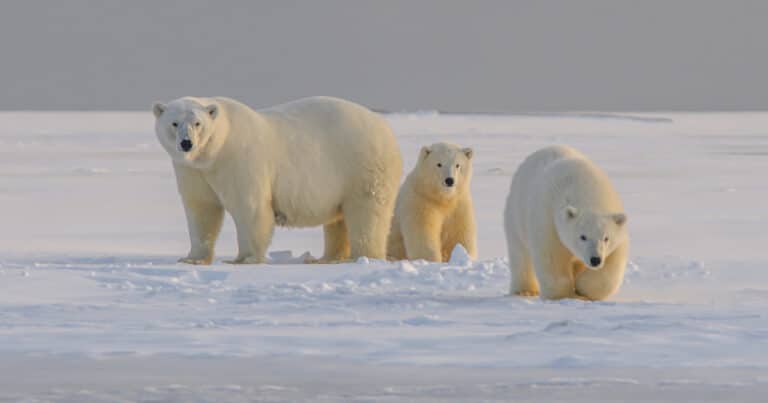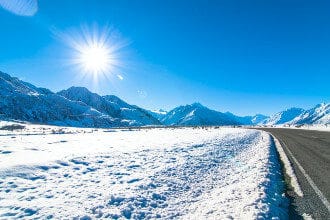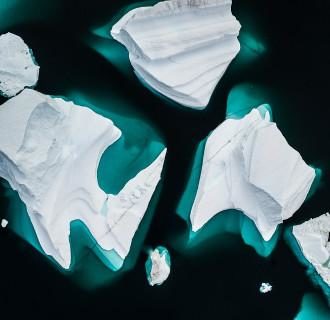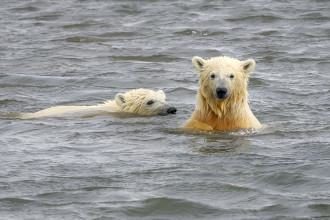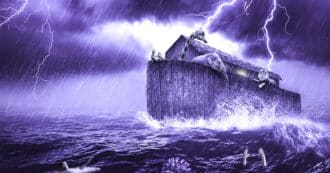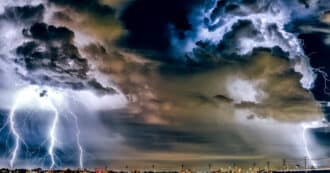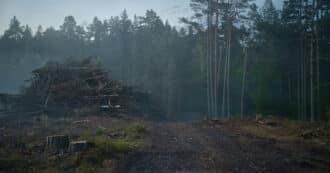Polar bears have long been a poignant symbol in the fight against climate change. The desperate pictures of polar bears stranded on blocks of melting sea ice, encapsulate a feeling of nature’s vulnerability in the face of so much human created change.
But are these once apex predators of the Arctic Ocean really going to be gone for good? Scientists agree that if we don’t put a halt on global warming, then the polar bears of the world will find themselves without a home.
Polar bears spend their lives in a very small and very niche habitat on arctic sea ice. This habitat, which is already very small, is one of the most affected regions by climate change in the world.
Furthermore, climate change will not just change the landscape of polar bear habitats, but will cause it to completely disappear. If the arctic sea ice melts in this way, it would not just spell trouble for polar bear populations, but for ecosystems and people around the world.
Global Warming In The Arctic
Increased amounts of greenhouse gas emissions has made global warming a serious issue felt around the world. But the places warming the fastest are the north and south poles.
This is due to something called surface albedo. Albedo is the measurement of how well something reflects light.
Light surfaces reflect more sunlight while dark ones absorb it. Snow has a high albedo, and is incredibly good at reflecting light, which is normally what helps the poles stay so cool.
However, as temperatures start to rise, the snow melts revealing dark ground underneath, this absorbs sunlight and makes the arctic even warmer. This makes it so that the arctic is not just warming fast, but at an exponential rate.
Polar Bear Habitat
This melting snow does more than just make the arctic warmer. It also destroys the most quintessential part of the vital habitat of the polar bear, arctic sea ice.
In order to understand why artic sea ice is so important to polar bears, it is important to understand how polar bears live. Even though polar bears are the largest land dwelling carnivore, they spend the majority of their lives on and around ice and water.
Polar bears are built to be able to swim for miles on end, and hunt for seals under thick layers of ice. This makes the large pieces of floating sea ice a perfect habitat for the Arctic’s top predator.
Habitat Loss
There are 19 different polar bear populations that live across the arctic circle everywhere from Alaska to Canada to Russia. Almost all of these polar bear populations could face extinction due to melting sea ice.
Arctic ice is essential for polar bears to survive. Some polar bears even spend their entire lives on this sea ice.
Sea ice is at its largest in the winter, but shrinks in the summer and spring. Normally, a polar bear would stay on the ice in the winter and go ashore when the summer ice melts, but with temperatures rising, the winter ice is melting sooner and there are less areas covered by summer sea ice.
This makes it increasingly hard for polar bears to survive. Polar bears rely on sea ice to hunt, and many polar bears that spend their entire lives on sea ice are finding themselves in an even more desperate situation, facing a total loss of habitat in the coming years.
Polar Bears are Vulnerable To Extinction
Polar bears are in an incredibly desperate situation. But what exactly does the future hold for them, and how can we stop more polar bears from dying?
However, the current classification of polar bears is that they are “vulnerable to extinction” under the International Union for Conservation of Nature, or IUCN. While this means that polar bears are a still a step above endangered, they are still at risk of going extinct.
This vulnerability to extinction is made even worse when we look at what the future might hold for polar bears. With an already melting habitat it is becoming increasingly difficult to fix the problem.
Climate Change Scenarios
Scientists have created several different scenarios of how much the Earth will warm during the rest of the century based on how much emissions we continue to emit. These scenarios are based on expecting carbon emissions to reduce, increase, or continue at the rate unabated.
The increased emissions scenario is, as one would think, the worst case scenario. If emissions were increase at a rate higher than they are increasing now, almost all polar bear populations would be completely gone.
This worst case emissions scenario would spell the end for one of the Earth’s largest animals. However, the other decreased and unabated carbon emission scenarios also hold a grim future for polar bears.
Is It Too Late for Polar Bears?
Under the projected scenario for decreased carbon emissions it is expected that our emissions would peak in 2040, and then start to decline. While this would ideally put an end to, or at least slow down, our warming climate, by that time polar bear numbers across the Arctic would have already declined drastically.
If greenhouse gas emissions continue as normal this sharp decline in polar bear numbers would happen about 25 years sooner. In other words, even if we start lowering our carbon emissions now, it may already be too late for polar bears.
The Impact of Declining Polar Bears
Polar Bears International, a non-profit dedicated to the conservation of polar bears, has highlighted a few different impacts that the extinction of polar bears would have on the human world. One of which is that as polar bears lose their habitat many would start to move ashore. While finding a new habitat ashore might seem like a good way of adapting, it often has some more gruesome consequences. When polar bears come ashore they risk interacting with coastal villages. These types of encounters are not only dangerous for humans, but also for the bears interacting with humans trying to defend themselves.
Polar Bears International also discusses how polar bears hold a very important cultural significance to indigenous people that live around the Arctic Circle. Without polar bears, many people will lose important hunting and religious traditions.
Polar Bears and Religion
Polar bears are deeply significant for Canadian indigenous people like the Inuit and Inuvialuit. These indigenous communities have been sustainably hunting the polar bear for generations.
Polar bears provide many resources to the indigenous peoples who hunt them. According to a 2017 Joint Management Plan, polar bears “meat nourished people and their dog teams alike, especially at certain times of the year when other food is in short supply. Polar bear pelts provide clothing, mattresses and tools. Apart from bears’ economic contribution, they also nourish the Inuvialuit imagination, due in large measure to their strength, agility, and above all, their great intelligence. Polar bears feature prominently in Inuvialuit mythology, spirituality, storytelling, art, song, and other forms of cultural expression and traditions”. Polar bears are essential to these communities’ spiritual beliefs and physical needs.
A traditional knowledge study on polar bears describes how “polar bears are greatly respected by Inuit hunters as the most intelligent animal in the Arctic, and as a symbol of the resilience, patience and determination that is need to survive in the harsh climate”. But, with climate change and melting ice, polar bears may not be able to overcome these existential threats. The Inuit and Inuvialuit built their societies to live in balance with polar bears. We also need to ensure our society exists in balance with other species. The ice may be melting, but it’s not yet too late. We need to act NOW!
* Featured image source

